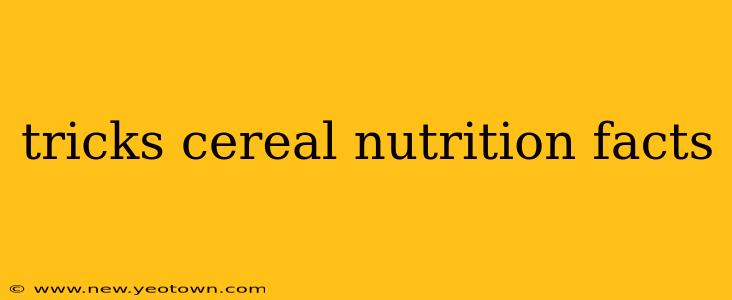Decoding the Cereal Box: Unmasking the Tricks in Cereal Nutrition Facts
Let's be honest, we've all been there. Standing in the cereal aisle, overwhelmed by colorful boxes promising everything from "whole grain goodness" to "immunity-boosting power." But are these claims always accurate? The truth is, cereal manufacturers are masters of marketing, using clever tactics to make their products appear healthier than they actually are. This isn't to say all cereals are bad, but understanding the tricks they use can empower you to make more informed choices. Think of this as your decoder ring for navigating the cereal jungle.
What are some common tricks cereal companies use on their nutrition labels?
This is a fantastic question, and it gets to the heart of the matter. Cereal companies utilize several strategies to manipulate how we perceive their products' nutritional value. One common trick is focusing on the positive while downplaying the negative. For example, a cereal might highlight its fiber content, which is good, but bury the high sugar content in smaller print or within a long list of ingredients. Another tactic is using vague terms like "made with whole grains" which sounds healthy but doesn't necessarily mean the cereal is predominantly whole grain. It's crucial to look beyond the marketing jargon and scrutinize the actual numbers.
How can I tell if a cereal is truly healthy based on its nutrition label?
This leads us to a crucial skill: reading the nutrition label with a discerning eye. Forget the catchy slogans. Focus on the numbers. Look at the serving size – it's often smaller than what you'd actually eat in one sitting. Pay close attention to the total sugars, added sugars, and fiber content. Aim for cereals with lower added sugars and higher fiber. Ideally, added sugars should be minimal or non-existent, while fiber should contribute significantly to the total carbohydrate count. Also, check the sodium content; you want it to be as low as possible. A healthy cereal will have a balanced nutritional profile, not just highlight one positive aspect.
What are some hidden sugars in cereals I should watch out for?
Many cereals contain hidden sugars disguised under various names. This is where reading the ingredients list carefully becomes paramount. Be on the lookout for ingredients like corn syrup, high fructose corn syrup, sucrose, dextrose, maltose, and various fruit juices concentrates. These all contribute to the overall sugar content. The longer the ingredient list and the more numerous the added sugars, the more likely the cereal is heavily processed and high in sugar. Remember, even seemingly healthy cereals like granola can be surprisingly high in sugar due to added sweeteners and dried fruits.
Are all "whole grain" cereals actually healthy?
While "whole grain" sounds like a health halo, it's important to read the fine print. A cereal might use a small amount of whole grains to qualify for the label, while the majority of the ingredients are refined grains, sugars, and other additives. Look at the percentage of whole grains listed in the ingredients – it should be a significant portion for the cereal to be truly considered a whole grain option. Consider cereals with only a few whole grain ingredients (like oats or whole wheat) as more trustworthy options.
How can I compare different cereals to find the healthiest option?
Comparing cereals effectively requires looking beyond the front-of-package claims. Instead, directly compare the nutrition facts panels of different cereals. Pay close attention to serving size, total sugars, added sugars, fiber, and sodium. A useful strategy is to calculate the sugar content per serving size (grams of sugar/serving size) and compare this across different cereals. This approach helps you to more easily gauge the true sugar density in each option.
In conclusion, navigating the cereal aisle requires a keen eye and a healthy dose of skepticism. By understanding the marketing tricks and learning how to read nutrition labels effectively, you can make informed choices and choose cereals that truly support your health goals. Remember, a little knowledge goes a long way in empowering your food decisions!

